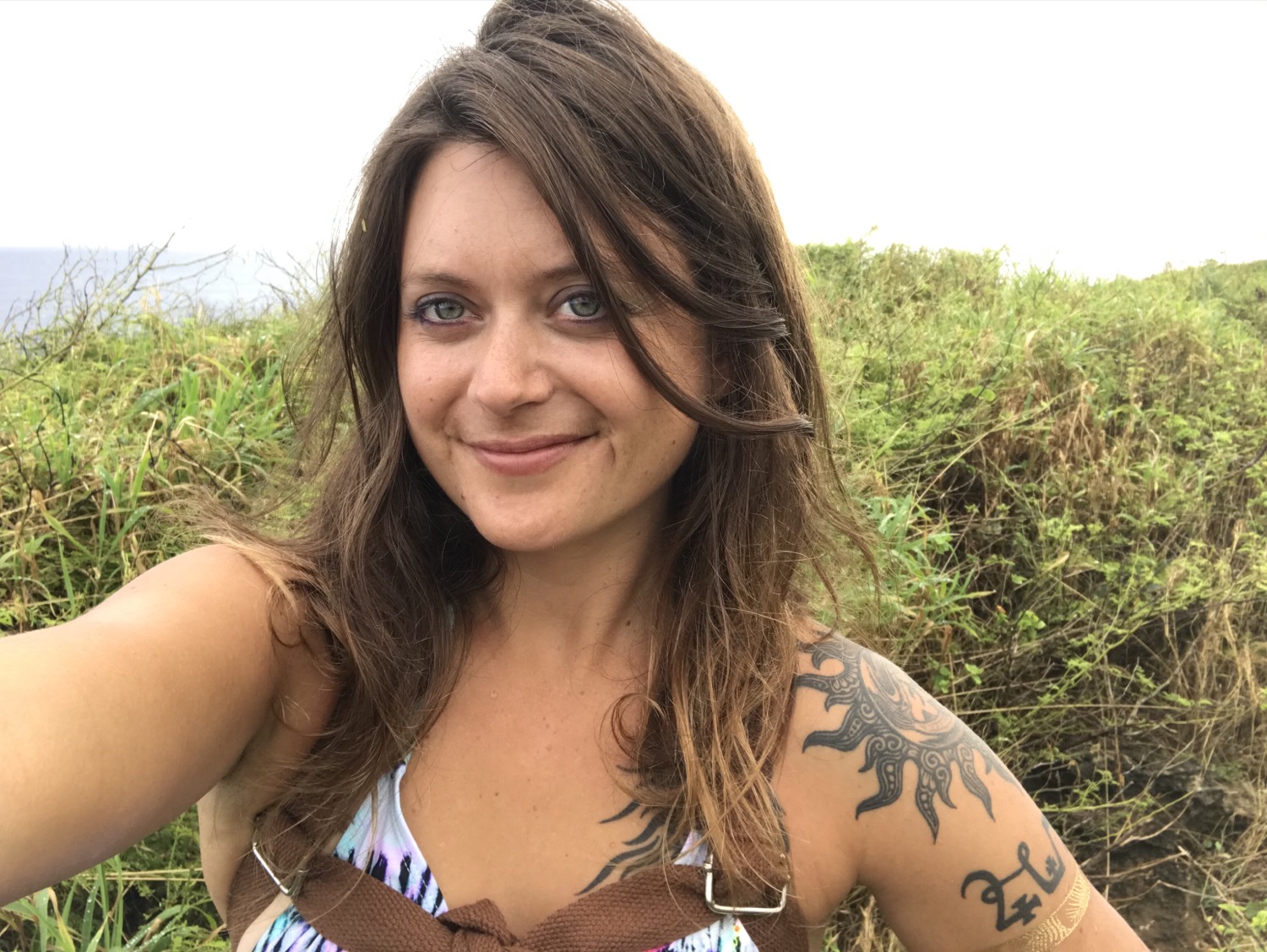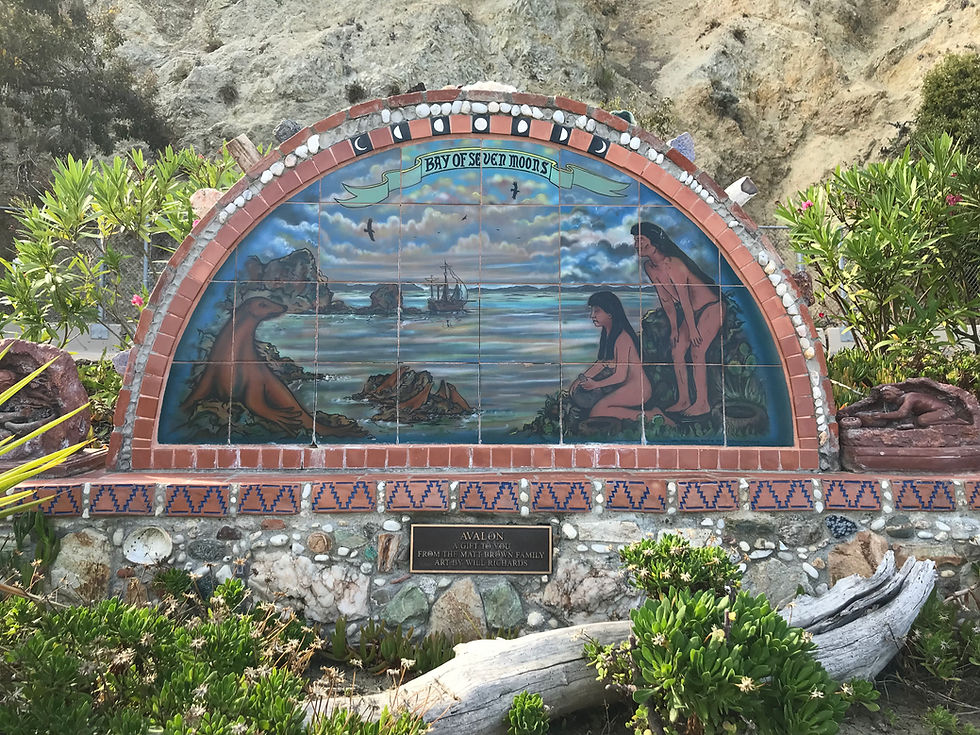The Bay of Seven Moons of Santa Catalina Island
- Stephanie Maher

- Sep 26, 2021
- 5 min read
Updated: Feb 29, 2024
To view previous blog: The Terrain and Sea Life of Santa Catalina
back to main page

Learning about our history will benefit our future. How will we know how to direct our future, if we do not know what we have accomplished in the past?
When visiting Catalina, you will notice the many images of Spanish Galleons on buildings, artwork, and tiles. “Why is this?” someone might ask. To answer this question, I would start by investigating the small monument along the walkway to the Casino Building. It is a circular sculpture with many types of crystals and minerals lining the perimeter. The sculpture has the depiction of the Native Americans creating soapstone bowls. You will also notice a Spanish Galleon in the background. The Spanish and English had explored the Channel Islands during the 16th century and interacted with the Native Americans and documented them. Above the image of the sculpture, you will also notice the words, “Bay of Seven Moons.”
When I was living on Catalina, I was amazed at the fact that many did not know why Avalon was once known as the Bay of Seven Moons! The term comes from the fictional book The Adventures of Torqua, that Dr. Charles Fredrick Holder had published in 1902. In his book, Charles Holder had imagined that the Native Americans that had once lived on Catalina referred to Avalon Bay as the “Bay of Seven Moons.”
The Adventures of Torqua is about a Pimu’gnan teenager, Torqua, who leads two Spanish teenagers, Raphael and Arturo, from the mission San Juan Capistrano to escape being taken up North by Spanish Soldiers. Torqua, Raphael and Arturo travel to Catalina and live inside of a rock shelter on the west side of the island while hunting for abalones and making tools like the people of the “Stone Age.” It is a great read, even though some say it does not accurately portray how the Native Americans had lived “per se.” However, most of what Charles Holder describes about the Pimu’gnans is credible. The rock shelter described in the book is based on a real archaeological site on Catalina which is called the Torqua Cave today. It is considered a highly sensitive site and it is protected by the Catalina Island Conservancy.
I believe that the book The Adventures of Torqua, is a historical and important book to read! But some think differently. The reason for this is because not only was Charles Holder the founder of the Avalon Tuna Club in 1898, but he was also one of the early naturalists that created theories about the origins of the Pimu’gnans and had excavated many ancient sites on Catalina and the other Channel Islands. He thoroughly wrote down his archaeological findings and ideas in his books. Charles Holder did this without the consent of the Native American descendants and his views are regarded as invalid because of this.
However, after having studied the Pimu’gnans and reading all of Charles Holder’s books myself, I believe Charles Holder contributed to the culture of Avalon and much of his written work about Catalina is credible and I believe it should be considered by anthropologists and archaeologists studying the history of the Channel Islands. For more on Charles Holder and his ideas and discoveries click the links to my blogs at the bottom of the page.
Time traveling back into the ancient past, let’s think about the Pimu’gnans. The Pimu’gnans are the Native Americans that once occupied Santa Catalina Island. The Pimu’gnans are considered part of the Tongva. The Tongva occupied the four southern Channel Islands, and the Chumash occupied the Northern Channel Islands. The Tongva occupied an area of about 4,000 sq. miles within the LA Basin just south of Chumash territory. Both the Chumash and Tongva arrived in the area around 10,000 years ago and share close ancestral ties even though there was differences in their language that had evolved over time. To put it simply, the Chumash spoke a Hokan dialect and the Tongva spoke a Uto-Aztecan dialect.
The Catalina Island Museum has on display impressive artifacts of these ancient Pimu’gnans.
The deer bone flutes on display demonstrate the importance of shamanism within the culture. It is a tool for communicating with the spirit world. The Pimu’gnans are described as being the “powerful ones” because of their ability to “bend trees and calm the oceans.” They are known for using the hallucinogenic and potentially poisonous plant called Datura wrightii as a tool for speaking with the spirit world. The different types of species of the Datura genus are found all over the world and considered sacred tools, a medicinal vehicle to the ‘other side’ by many ancient cultures. It is seen in India, Africa, South America, Mexico, Southeastern China, to name a few places.

My favorite artifact at the Catalina Island Museum is the massive 138lb soapstone ceremonial Urn. “The Urn” is perfectly round and smooth and it demonstrates sophistication within the ancient culture. Try to imagine the process of making a soapstone urn like the one on display without our modern technology. We would have to quarry a stone that is bigger than 138lbs, then carve out a perfectly round and symmetrical, while also making the urn slant upward. Soapstone is a relatively soft stone, (5.5 in the Moh’s scale) but if I were to even attempt to create an urn like the one on display, I would have to try and fail 100 times, even with modern technology! It would take my entire lifetime, or many lifetimes, to create the 138lb urn that is on display. “The Urn” is a legacy of craftsmanship that deserves to be recognized as such! It would be a disservice to the culture to suggest otherwise.
Soapstone effigies of pelicans, sea lions, soapstone ceremonial staffs and toruses are also on display. Soapstone was also carved and crafted by the Egyptians, Minoans, Indus Valley civilization, Chinese and Australian Aboriginals. The Pimu’gnan exhibit at the Catalina Island Museum is only a tiny fraction of what was found on Catalina, yet it shows the exquisite craftsman of these ancient people that had almost been wiped out by early Spanish explorers and settlers during the 18th century by disease and missionization.
In the Museum Gift Shop I bought a small soapstone bowl that fits into the palm of my hand. It was created by a local artist, Buck Lopez, with modern power tools. His soapstone bowls are created to mimic the ones the Pimu’gnans had created in the past. To buy a soapstone bowl go to the Catalina Island Museum’s online store!
To go to Previous Blog: The Terrain and Sea Life of Santa Catalina Island
To go to main page: The Secret of the Torqua Cave


Comments